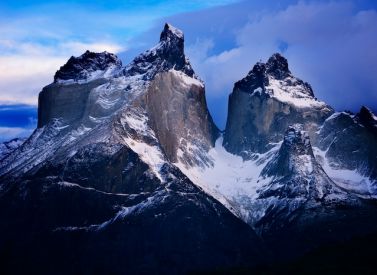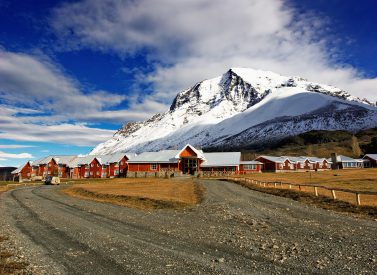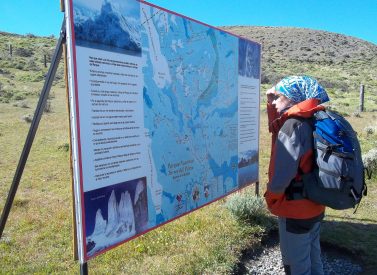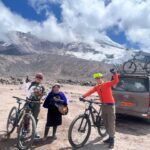
Paine O Circuit Full Trek: Guided
Hike the famous Torres del Paine O Circuit trek: Guided.
The Paine Circuit hike is one of Patagonia’s and indeed the world’s classic trekking trails.
This is a stunning trekking holiday, where we mix eco-camps with remote campsites as we walk the Torres del Paine National Park circuit.
We hike around the entire famous craggy Paine massif, adding the back of the park to the shorter W trek.
These guided Paine Circuit treks are for adventurous and physically fit travellers, visiting beautiful and remote mountain wilderness areas of southern Chile.
More on trekking the Torres del Paine Circuit trek
The Paine Circuit is rightly regarded as one of the world’s classic trekking routes.
The Paine Circuit trekking route encompasses Paine and Dickson Lakes, Los Cuernos and the Torres of Paine, as well as Grey Glacier, seen from the pass.
We provide pack horse and porter support to help share the load as you make your way around this amazing Patagonia trekking circuit.
In good weather you will have a stunning view over the South Patagonia Icefield as you cross the John Gardner pass, and possibly spot an elusive puma.
You can upgrade to spend some nights in cosy eco-camps, too.
Try our Paine W Classic trek—guided or self-guided—if looking for a quicker but equally stunning hike.
Trip Highlights
Print Share Download as PDF-
Complete Paine Circuit including the epic John Gardner pass.
-
Grey and Dickson glaciers, plus options to kayak.
-
Great wildlife spotting chances in Torres del Paine National Park.
-
One of the best treks in all of South America.
This was a truly excellent trip, thank you.
From the organisation at your end through to the meet-and-greet and the entire treking experience I would rate the trip as 5 stars.
The trekking itself is of moderate severity - no problem if you are fit but not for the unfit. The eco camp is a must for it sunique and restfull atmosphere - and that bit of luxury after 6 days in the mountains.
The weather for my trip was extraordinary - blue skies and sunshine combined with waist deep snow and cold nights made for a truly beautiful experience.
Coming over the pass at 11.00 in the morning in deep snow and bright sunshine to see the Patagonian Ice Cap spread out before us was a truly life-long moment.
I would highly recommend this package with Andean Trails.
A. Curran, Paine Circuit
Full Itinerary
Day 1: Transfer to Paine, trek to Camp Serón (L,D)
Note: Trekkers must sleep in Puerto Natales the night before the Paine Circuit trek starts (hotel not included).
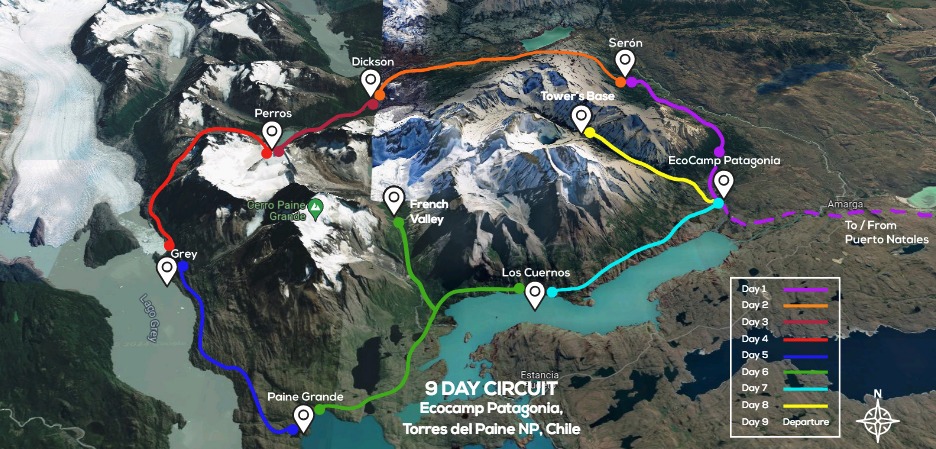
Camp Serón
Pick-up at 09.00 from your hotel and drive two hours to EcoCamp Patagonia in Torres del Paine National Park. Lunch is served at the EcoCamp in the community dome.
Next, receive a trek briefing and duffel bags to organise the coming trekking days. Leave any excess luggage at the EcoCamp.
Our first half-day hike is from the EcoCamp to the remote Camp Serón, around four hours of walking. Light lingers in Paine, with summer days stretching to as late as 11pm.
Distance: 13 km/8 miles, 4 hours approx.
Max. Altitude: 392m/1,286ft
Elevation gain: 386m/1,266ft
Day 2: Camp Serón – Lago Dickson, camp (B,L,D)
Today we head to Dickson lake. Here, we are greeted with a spectacular view of Glacier Dickson and part of the Hielo Patagonico Sur (South Patagonia Ice Field). We head along the eastern bank of the Rio Paine and we stop at a lookout point with a wonderful panoramic view of Lago Paine below.
Next, we descend to the lake’s shores and then continue across open grasslands along the Rio Paine to Refugio Dickson. Our stunning campsite is in the Dickson Valley, surrounded by towering snow capped peaks and the pretty waters of Dickson Lake with Mt. Cubo in the distance. Hot showers available.
Overnight camping at Dickson.
Distance: 18.7 km/11.5 miles, 5.5 hours approx.
Max. Altitude: 382m/1,255ft
Elevation gain: 622m/2,040ft
Day 3: Lago Dickson - Los Perros, camp (B,L,D)
The trail follows Los Perros river and encounters the wildest and least accessible section of the trek.
We walk through beech forests to the lovely Laguna Los Perros where we set up camp.
Spend the night camping at Los Perros.
Distance: 12.9 km /8.1 miles, 5 hours approx.
Max. Altitude: 584m/1,916 ft
Elevation gain: 373m/1,224ft
Day 4: Los Perros - Camp Grey, camp (B,L,D)
In this section we reach the highest point of the circuit at 1,300m/4,00ft with an awe-inspiring view of the Grey glacier, an enormous fractured mass of ice choking the valley.
The route continues roughly south along forested slopes, giving beautiful views of the enormous Glacier Grey (more than five miles across and ten miles in length).
Overnight at Camp Grey.
Distance: 17.3km/10.7 miles, 12 hours approx.
Max. Altitude: 1,364m/4,475ft
Elevation gain: 984m/3,228ft
Day 5: Camp Grey - Lago Pehoe, camp (B,L,D)
After the previous days’ efforts, today you have plenty of time to rest and enjoy Grey Glacier and its surroundings.
*Optional Kayaking around Glacier Grey (extra cost): This excursion starts at 09.00 and lasts 2.5 hours. Kayak around huge floating icebergs, towards the east side of the glacier to get closer to the giant ice wall.
Min. age is 15-years-old, max. age is 65-years-old. (kayaking option is only available until March 19th).
After having lunch it’s time to continue trekking. We hike along the eastern side of Grey Lake.
En route, there are views over the lake, with numerous giant icebergs drifting across its waters making impressive viewing.
The last hour is a descent to Lago Pehoe, where we spend the night camping at Paine Grande.
Distance: 11km/6.8 miles, 5 hours approx.
Max. Altitude: 302m/990ft
Elevation gain: 243m/797ft
Day 6: Camp - French Valley, camp (B,L,D)
After breakfast, we set off on what will be a challenging but rewarding trek to Valle Frances (French Valley). This is a fairly steep trail that goes right into the heart of the Paine Massif.
A couple of hour’s walking leads us to the hanging bridge over the French River (Rio Frances), located at the foot of the south east face of the Massif. From this point, we get some wonderful views. We continue up the trail, following the river, to access the upper reaches of the French Valley.
As the trees clear, we entire a morraine cauldron, fortressed on almost every side by an impressive range of stunning mountains. Among the most striking are Hoja (Blade), Máscara (Mask), Espada (Sword), Catedral (Cathedral), Aleta de Tiburón (Shark’s Fin) and the magnificent Fortaleza (Fortress).
If you turn 180 degrees to look at the path you have just climbed, you will get a lovely view of the lakes and green hills that provide a stunning contrast to the mountains immediately behind you.
At the viewpoint, we have a picnic and for those willing, there is an optional trek to Mirador Britanico, a small hut built by a British climbing expedition, to get a view from higher up the Valley. Now fed and watered, we descend the way we came and then turn east to reach our campsite, Camp Francés.
Distance: 20 km/12,4 miles, 8 hours approx.
Max. Altitude: 800m/2,624ft
Elevation gain: 753m/2,470ft
Day 7: Nordenskjold Lake traverse, camp or eco-camp (B,L,D)
Today we head back to the EcoCamp through the curly Cuernos trail located which hugs the beautiful Lake Nordenskjold.
As on most of the walk, we are accompanied by magnificent views, this time of the park’s central lakes. The trek ends at the EcoCamp where your evening is free to enjoy dinner and look forward to tomorrow’s highlight – the Towers (Torres) of Paine!
Stay at Torre Central Camp or upgrade to the EcoCamp Patagonia domes.
Distance: 16km/9.94 miles, 6-7 hours approx.
Max. Altitude: 247m/810 ft
Elevation gain: 181m/594ft
Day 8: Valle Ascencio, camp or eco-camp (B,L,D)
A long day’s trekking but with a great reward at the end. We start our trek by hiking to the foot of the impressive granite massif of the Towers of Paine. From here you can admire the Paine Towers rising above the green lagoon that sits at their feet.
The famous Towers of Paine (2,900m/9,400ft) consist of three gigantic granite monoliths, remains of a great formation that has been sheared away by the forces of glacial ice.
It’s not a difficult walk, but energy should nevertheless be saved for the final challenge: the moraine. This mass of boulders is the last guardian before our face to face meeting with the uplifting Torres del Paine. The moraine is sufficiently steep to consider doing it slowly and with an adequate amount of precaution.
After a considerable effort, the Towers come into full view, rising majestically before us with the glacial lake visible below. The famous Torres del Paine (2,900m/ 9,400 ft) consist of three gigantic granite monoliths, the remains of a great cirque sheared away by the forces of glacial ice.
We take lunch at the feet of the mighty Torres del Paine, and once everyone is ready, we backtrack along the same trail through Ascencio Valley, and return to camping Las Torres. This is our last night in Torres del Paine, and a chance to recount the previous days’ adventures.
Overnight camping in Las Torres or upgrade to EcoCamp Patagonia domes.
Distance: 22 km/13.6 miles, 10 hours approx.
Max. Altitude: 914m/3,000ft
Elevation gain: 796m/2,611ft
Day 9: Transfer out, ends (B,L)
Early this morning we wake up, pack up our belongings and drive out (departure time between 8-10am), having completed the Paine Circuit trek.
Puerto Natales airport or hotels: Arrive between 10am-noon
Punta Arenas airport: Arrive after 1-1.30pm. Book flights departing 14.30 or later.
Punta Arenas hotels: Arrive 1-2pm.
For El Calafate: Private transfer from Eco-camp to Cerro Castillo to catch the morning public bus to El Calafate (bus and transfer included in tour price), arriving around 2pm.
Note: We reserve the right to change the order of the days in any itinerary under the sole discretion of the trip guide and based on operational considerations. The trip guide can also modify, change or eliminate part of the itinerary based on safety/weather considerations.
Only passengers with upgrade will have access to facilities at the Eco-Camp.
Prices From $3,791 / £3,082 per person
What's Included?
All ground transport, 8 nights camping, park fees for Cueva del Milodon and Torres del Paine National Park, meals as indicated, dining & camping equipment, ferry crossing over Lake Pehoe, English speaking trekking guide, assistant guide provided if 4+ on trip, porter service
What's Not Included?
International and domestic flights, hotel night in Puerto Natales before the trek starts, insurance, personal items, sleeping bag and sleeping mat, Grey Glacier ice trek, tips, personal items, alcoholic or soft drinks.
Accommodation
Camping and refugios. Option to upgrade (subject to availability) on days 7 and 8 to EcoCamp Patagonia.
Camping: The tents arranged for this program are typical mountain tents with enough room for 2 people overnight in comfortable conditions. We provide all the camping gear but you have to bring your own mat and sleeping bag (please ask us for mats and bags rental rates).
Our team will be responsible for setting up the tents in the camping site. There will also be a big and comfortable dining tent for enjoying dinners and breakfasts. Additionally, the camping sites along the trek will have mountain bathroom facilities in good condition.
EcoCamp: EcoCamp Patagonia is located in the heart of Torres del Paine National Park in Chile, with a unique view of the majestic granite towers. The region’s first fully sustainable accommodation south of the Amazon and the first of its kind in the Patagonian wilderness, EcoCamp offers upscale camping in geodesic domes inspired by the region’s ancient nomadic inhabitants.
EcoCamp standard domes were the world’s first Geodesic Dome hotel room. At 3.6m/12ft in diameter and 2.4m/8ft in height, they allow two people to sleep and stand comfortably inside. They are resistant to the strongest Patagonian winds, rains, and snow, and come equipped with two single beds (doubles on request), a radiator for heating, very cozy fleece blankets, feather quilts and organic elements for decoration. There are round windows in the ceiling to look at the stars. Eco-Camp’s standard domes offer shared bathrooms, which aid our environmental initiative by collecting waste in a central heated composting chamber and allowing more control of water consumption and heating.
Superior Domes at EcoCamp are spacious, comfortable and equipped with private bathrooms, Superior Domes are the optimum choice for trekkers wanting that bit more space and comfort at the end of a long day’s walk. Guests can fall asleep looking up at the star-lit sky from their cozy bed and wonder at nature’s immensity as they hear the wind hurtling outside. Each Superior Dome has comfortable queen-size or twin beds, a propane heater and a private bathroom with a sophisticated composting toilet.
Suite Domes at EcoCamp are comfortable Geodesic domes (28m2 / 300ft2)built in the same shape as the ancient Kaweskar tribe dwellings. Their structure produces minimal environmental impact while providing an efficient thermal and wind-resistant unit, with great exposure to nature in the most magnificent Patagonian setting. Guests can gaze at the stars through the ceiling windows while falling asleep each night, after enjoying a spectacular sunset from their private terrace.
Each Suite Dome has comfortable double or twin beds, a private bathroom with a state-of-the-art composting toilet and a modern low-emission wood stove. Electricity is very limited inside the domes, meaning hairdryers are not permitted, but laptops and cameras can be charged. Inside Suite Domes, an open terrace to read, relax and admire the view.
Enclosed porch to hang wet clothing; Comfortable King-size or twin beds; Low-emission wood stove; Patagonian decoration; Propane heater in bathroom; Private fully-equipped bathroom; State-of-the-art composting toilet.
Tour Staff
Guides are English-speaking trekking experts with many years’ experience of trekking in Paine.
The EcoCamp, and porters, are locals, contributing to the economy.
Meals
We can cater for almost all dietary requirements – please enquire for more.
While trekking, you usually wake early, around 07.00. If you are staying in refugios, you will be in a bunk bed in a dorm, and meals are eaten in a communal dining hall. If there is no space in the refugios, we camp in the grounds, and your meals are prepared and served to you in a dining tent, and will be a mix of hot drinks, cereals, fruits and toast with jams.
After breakfast, packs are prepared and your guide will explain the day’s walk, and you typically walk 3-4 hours in the morning before lunch, with a short or break or two en route.
Each trip will have its own menu depending on the local food and typical dishes prepared in the area and on many trips meals are enjoyed in restaurants providing a wide array of local cuisine.
At EcoCamp Patagonia a lot of effort has been put into developing a menu of fresh hearty meals using locally-sourced ingredients. Meals at mountain huts on trekking routes are simple but plentiful.
Activity Level
This is a moderate to strenuous trek. There is no high altitude to deal with, but days can be long and conditions can be tough.
This is the right trip for energetic people who like to be active and have a spirit of adventure and a positive attitude. To enjoy this trek it is essential to be in shape before you arrive.
It is not wise to regard this trek as a means of getting into shape or losing excess weight. Start a program of conditioning well before departure.
Practical Information
Introduction to Patagonia
For most people, Patagonia evokes a vast, windblown plateau, jagged mountains and the life of the gauchos.
The steppe that occupies much of southern South America is only one aspect of a magical region, jam-packed with amazing and contrasting landscapes.
Patagonia (latitudes 40°-55°, approximately) embraces a vast portion of southern Chile and Argentina, from the Rio Colorado in the north, to Tierra del Fuego in the south.
For convenience, we have divided the region into three zones: the Lakes District of northern Patagonian, central Patagonia and southern Patagonia.
Geography of Patagonia
Southern Patagonia (latitudes 49° to 55°), encompassing the southern Andes of Chile and Argentina plus Tierra del Fuego, has an altogether more vertical aspect than the rest of Patagonia.
As the continent tapers towards its southern point, the Andes take on new characteristics and offer some truly impressive panoramas.
Much of southern Patagonia is characterized by virgin landscapes where man’s hand has either not been present or, because of the scale of the landscapes, goes almost unnoticed. To the west of the semi-arid Patagonian plateau, mile-high granite spires – e.g. Cerro Torre and Fitzroy in Argentina and the Torres and Cuernos del Paine in Chile – rise abruptly from the Andean foothills, while vast blue glaciers, fringed by southern beech forest, gouge out thevalleys below.
At the heart of these magnificent landscapes lies the South Patagonian Ice Field, an utterly remote icy wilderness spanning hundreds of kilometers, whose glaciers – including the Perito Moreno and Upsala – are tens of kilometres long by severalkilometers wide.
Also characteristic of the southern Patagonian Andes are its turquoise, iceberg-filled lakes. To the west lies the southern portion of the Chilean Archipelago, comprising snow-capped islands and fjords.
Across the Magellan Straits from mainland Patagonia lies Tierra del Fuego which, like the rest of Patagonia, is divided between Argentina and Chile.
The north and east of Tierra del Fuego is flat, but flanking the Beagle Channel in the south, the tail end of the Andes provide very dramatic mountain scenery.
The Lake District (latitudes 40° to 45°) or the Araucania, is a region of dramatic conical volcanoes, evergreen, high-canopy forests and, of course, lakes.
It straddles the Chile-Argentine border, and also takes in Chiloe island, in the extreme north of the Chilean Archipelago. This region stretches from Temuco in the north to Chiloe in the south.
Central Patagonia (latitudes 45 to 49) is one of South America’s best-kept secrets. The vast wilderness area can be divided in two:
- The dry band of Andean foothills and wind-blown plateau lying on the Argentine side of the Andes. This remote area is traversed north to south by a gravel highway known as the Ruta Cuarenta (Highway 40).
- The Chilean portion to the west of the Andean watershed, often referred to as the Careterra Austral (after the little-used gravel highway that crosses it from north to south).
This huge region, embracing the sparsely-inhabited southern Araucaria and Aisén Region, features temperate rainforests, snow-peaks (often extinct volcanoes), lakes and, to the west, the Chilean Archipelago: a labyrinth of fjords and mountain-islands. This, the Chilean portion of central Patagonia, boasts the northernmost of Patagonia’s many giant, sea-level glaciers.
The San Raphael Glacier, probably this region’s most famous landmark, is an immense hanging glacier whose seracs calve into an iceberg-filled lagoon.
Find out more about Patagonia with our blog about its wildlife.
Porters and luggage
Porter service for this trip is included in the price.
During the trek, your belongings will be carried in three portions.
One portion you carry yourself in your daypack – this will be comprised of your lunch, water, camera, sun cream, etc. and the clothing you will layer on and off as the weather and terrain change during the day.
The second portion is your sleeping bag and sleeping mat (you need to bring these with you to Torres del Paine) which will be carried for you throughout the trip.
The third portion is changes of clean clothes and items you will need at night in the campsites – they will be carried for you in our waterproof duffel bags as follows:
On day 1 we will provide you with two small 15 litre duffel bags. You are allowed to pack up to 5 kgs (11 lbs) in each duffel bag.
In the first bag you will put clothes and items needed for the nights of days 2 (Dickson) and 3 (Los Perros) and the next morning.
In the second bag you will put clothes and items needed for the nights of days 4 (Grey), 5 (Pehoe), and 6 (Cuernos).
We use porters on days 2 and 3 to carry your first duffel, your sleeping bag and pad, as well as the common food and camping equipment. You will hike with only your daypack.
On day 4 (Los Perros) you will walk with your daypack towards Camp Grey and after your arrival, your first duffel, now with dirty clothes, will be sent back to Eco-Camp as the second duffel bag (packed on day 2) will be waiting for you with a new supply of clean clothes.
On day 5 (Camp Grey to Camp Paine Grande), 6 (Camp Paine Grande to Camp Cuernos) and 7 (Camp Cuernos to Eco-Camp) porters will be used again and your second duffel bag will be with you until your return to Eco-Camp on the evening of day 7.
All of your travelling baggage not needed for these sections of the trek will be left on the morning of day 2 at Eco-Camp where you will find it again on the nights of days 7 and 8.
Kit list
Good kit is vital for every trip.
Book with Andean Trails and get 15% off Páramo’s fantastic ethical and high performance outdoor gear.
Overview
When planning for the varied climatic conditions encountered in Patagonia, layering is the most practical and versatile clothing system. It’s worth remembering that our clothing keeps us warm by retaining and isolating the heat we ourselves create.
To best maintain body heat, several layers of lightweight, warm and quick-drying clothing are far more efficient than one or two thick layers. Layers should have the following qualities:
- Breathability (able to wick away the humidity produced by sweat):
- Isolation (able to keep in the warm air our body produces); and
- Impermeability (able to impede the passing of wind and water).
First (base) layer: This layer wicks the sweat away from our skin, thus helping keep the body dry and warm. To this end, synthetic fabrics such as polypropylene should be used.
Mid layers: These isolating layers should also be synthetic (e.g. the known polar linings such as polartec or windblock, which are light and insulate twice as well as wool). Very important layers for retaining body heat.
Outer layer / shell: Finally, the vital layer which protects us from climatic adversities. A breathable, wind-proof and waterproof anorak, such as Goretex.
Give plenty of thought to kit selection, and try to keep weight down.
We also carry an extensive first aid kit & oxygen on all trips, but these are generally for emergencies only.
Below is a more detailed kit list.
Detailed kit list
- Sleeping bag (3-4 season,25°F. to 45° F, to sleep in Mountain refugios and from 15° to 32ºF for camps)
- Sleeping mat/thermarest
- Day backpack (20-30 litres)
- Backpack or duffel bag (70 litres)
- 2 pairs synthetic inner socks (e.g. polypropylene, thermastat, coolmax) and 2 pairs thick loop-stitch/wool socks for cold.
- Trekking boots – should be well broken-in, waterproof and provide good ankle support.
- Trainers/sandals for city-wear, evenings at lower camps & river crossings.
- Base layer leggings (1 pair).
- Thick fleece leggings (or salopettes) (1 pair).
- Goretex-type over-trousers (or salopettes) (1 pair).
- Gaiters (optional).
- Trekking trousers (2 pairs).
- Shorts – wear sparingly in early stages at altitude, as sun burns.
- Thermal base layer shirts (2).
- Microfleece mid-layer shirt (1).
- Shirt/t-shirt 1 or 2 for lower altitudes. Long-sleeved, collared shirt protects against sun
- Fleece jacket or similar (1).
- Warm jacket (down or synthetic). For camp and upper slopes.
- Waterproof Goretex-type jacket.
- Broad-brimmed sunhat, essential.
- Warm hat, fleece or wool. (N.B. Up to 30% of body heat can be lost through the head).
- Sunglasses with UV filter.
- Scarf for cold.
- Bandanna – to protect neck from strong sun.
- Light inner gloves
- Warm gloves, e.g. fleece, and outer waterproof gloves or mittens (1 pair)
- Mittens allow you to keep the fingers together, and better conserve heat (though they also make it difficult to perform certain tasks).
- Pair of telescopic trekking poles (optional).
- Water bottle (2 litres approx.) & purification tablets.
- Personal first-aid kit to include: painkillers, plasters (band-aids), moleskin, anti-biotic cream, general antibiotics (ask your GP), after-bite (tiger balm), anti-diarrhoea tablets, throat lozenges, re-hydration salts & personal medication.
- Insect repellent.
- Towel & wash-kit.
- Wet Wipes/antiseptic hand-wash cream.
- Toilet paper (1)
- Sunscreen (factor 30+) and lip salve.
- Head-lamp (plus spare bulb and batteries).
- Penknife.
- Travel alarm clock.
- Plastic bags – ‘Zip-loc’ & tough bin liners.
- Camera and film / memory cards (take at least twice the amount you think you will need!).
- Book, e-book, mp3 player/ipod or other for free time.
- Binoculars.
- Spanish/English phrasebook.
- Extra snacks i.e. cereal bars or favourite chocolate bars.
All non-personal trekking / camping gear e.g. tents, cutlery etc is provided.
Miscellaneous others
- Money belt.
- Passport.
- U.S. dollars cash, mixed-denomination notes, undamaged and unmarked.
- ATM cash/credit card.
- Any inoculation certificates.
- Personal & medical insurance certificates.
- Presents e.g. Postcards from home.
- Comfortable clothes for travel, smart clothes for night life.
Quick facts about Patagonia
Chile
Official name: Republic of Chile
Country population: 17,000,000
Capital city: Santiago (6 million)
Largest cities: Santiago, Concepcion, Valparaiso
Languages: Spanish (official)
Official currency: Chilean Peso
Major industries: Copper mining, agriculture, fish
Time zone: GMT-5 in winter (Mar-Sep) and GMT-4 in summer (Sep-Mar)
Argentina
Official name: Argentine Republic Country
Population: 40,000,000
Capital city: Buenos Aires (11 million)
Largest cities: Buenos Aires, Cordoba, Rosario
Languages: Spanish (official)
Official currency: Argentine Peso
Major industries: Agriculture (Soy), motor vehicles, chemicals
Argentina: GMT-3
ATOL holiday protection
Andean Trails has 25 years of experience of putting together the best South America holidays.
We pay a fee to the CAA for every licensable passenger we book since we hold an Air Travel Organiser’s Licence granted by the Civil Aviation Authority. In the unlikely event of our insolvency, the CAA will ensure that you are not stranded abroad and will arrange to refund any money you have paid to us for an advance booking.
We also offer ATOL (Civil Aviation Authority) protected holidays to give our customers peace of mind when booking and travelling.
When you buy an ATOL protected air holiday package from Andean Trails Ltd you will receive a Confirmation Invoice from us confirming your arrangements and your protection under our Air Travel Organiser’s Licence number 6275.
You can read more about ATOL, who is covered and what protections you have if not ATOL-covered, on our ATOL page.
What is ATOL?
The CAA’s ATOL scheme offers protection to your money and your holiday if you book with us. Not everybody is covered (see ‘Who is covered?’ for more), as you must purchase an ‘air package holiday’ with Andean Trails to be protected.
And ‘air package holiday’ is defined as including a flight and some ground services (hotel, transfer, trek etc). This is also known as an ‘ATOL-protected holiday’.
Who is covered?
To be covered by ATOL, you must book a flight and some ground services with us and be from the UK. If you are from the UK and only book ground services and no flights, you are not covered by ATOL (see below for more on how non-ATOL clients are covered).
If you are outside the UK and buy flights with us, you will be ATOL protected IF any of the flights booked with Andean Trails touches/stops in the UK at any point during your holiday package booked with us.
If you buy your flights elsewhere, please check with that agent if you are ATOL protected. Be careful with online flight purchases and make sure you know what protection you have, if any, before paying for flights.
Not all holiday or travel services offered and sold by us will be protected by the ATOL scheme. Please ask us to confirm what protection may apply to your booking.
For land only holidays not involving any air travel, in accordance with “The Package Travel, Package Holidays and Package Tours Regulations 1992”, all UK passengers booking with Andean Trails Ltd. are fully protected for the initial deposit and subsequently the balance of all money paid to us, arising from cancellation or curtailment of travel arrangements due to the insolvency of Andean Trails.
I’m not ATOL covered, what protection do I have?
If you are not ATOL covered, any payments you make to us go to a Trust account.
We can only access this money once your tour has been completed, meaning that if anything happens to Andean Trails Limited while you are on holiday, then your money is secure and you can either complete the trip or be able to make it home.
If you pay for your holiday with a credit card, some offer payment protection – please check with your cardholder.
You also should have cancellation protection written into your insurance (which we recommend you have at the time of booking) in case you need to cancel.
Available Dates
05th Nov 2025 - From $3791 / £3082.083
Wednesday departures November through March, 2025-26 prices.Camping and shared tent basis.
Dec 17, 24, and 31 departures (peak season): USD 4,131pp
Upgrades to EcoCamp/refugios at extra cost
Private departures available

Dates & Prices
Select an available date to view pricing and information for that particular trip.
Wednesday departures November through March, 2025-26 prices.
Camping and shared tent basis.
Dec 17, 24, and 31 departures (peak season): USD 4,131pp
Upgrades to EcoCamp/refugios at extra cost
Private departures available
Can’t find what you’re looking for? Get in Touch
+44 (0)131 378 5593
+44 (0)131 554 6025



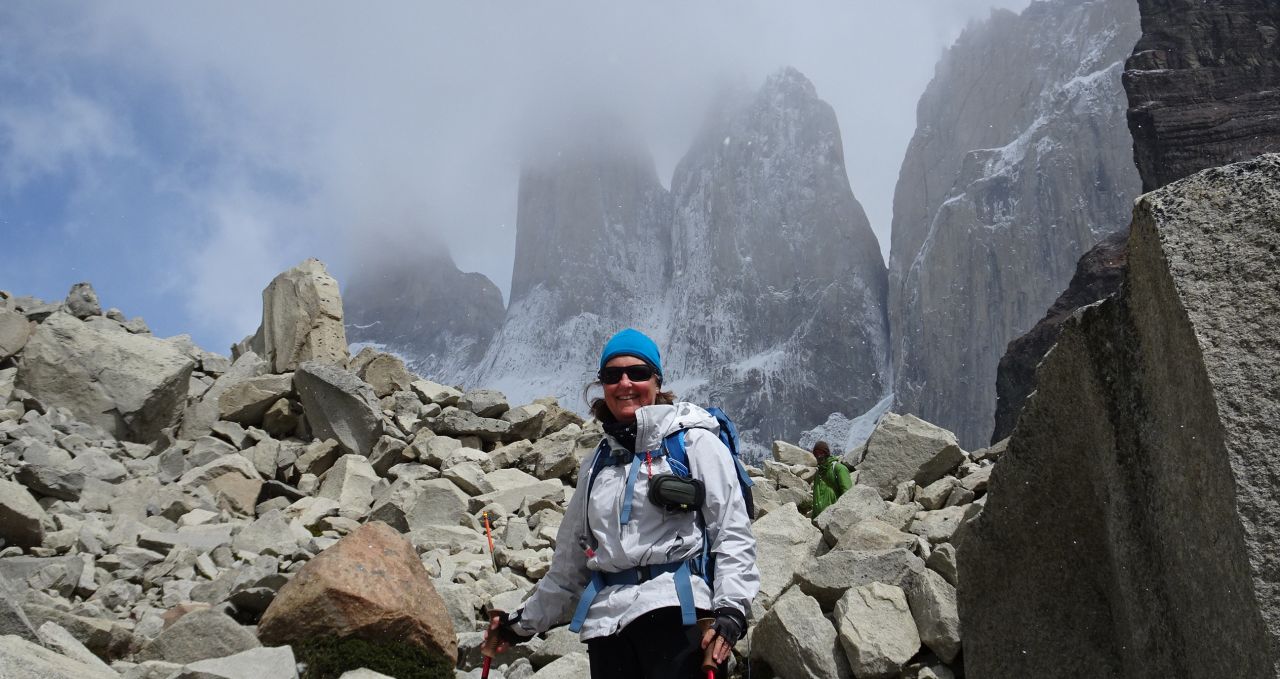
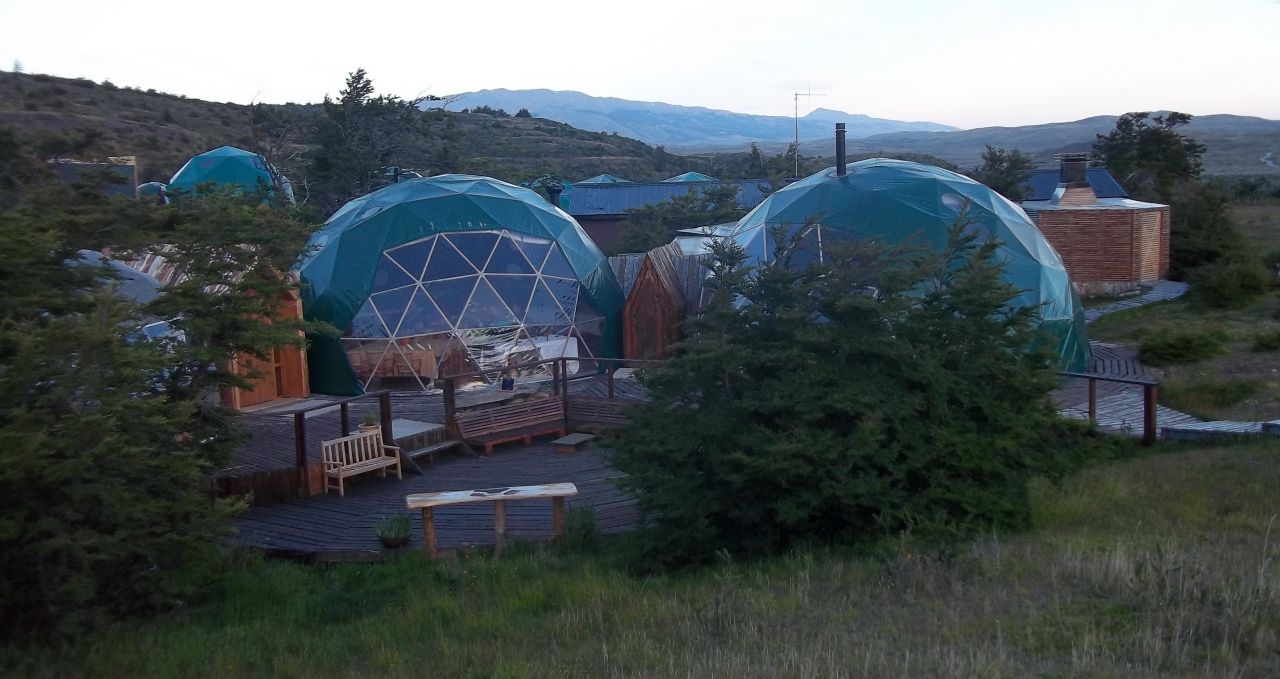
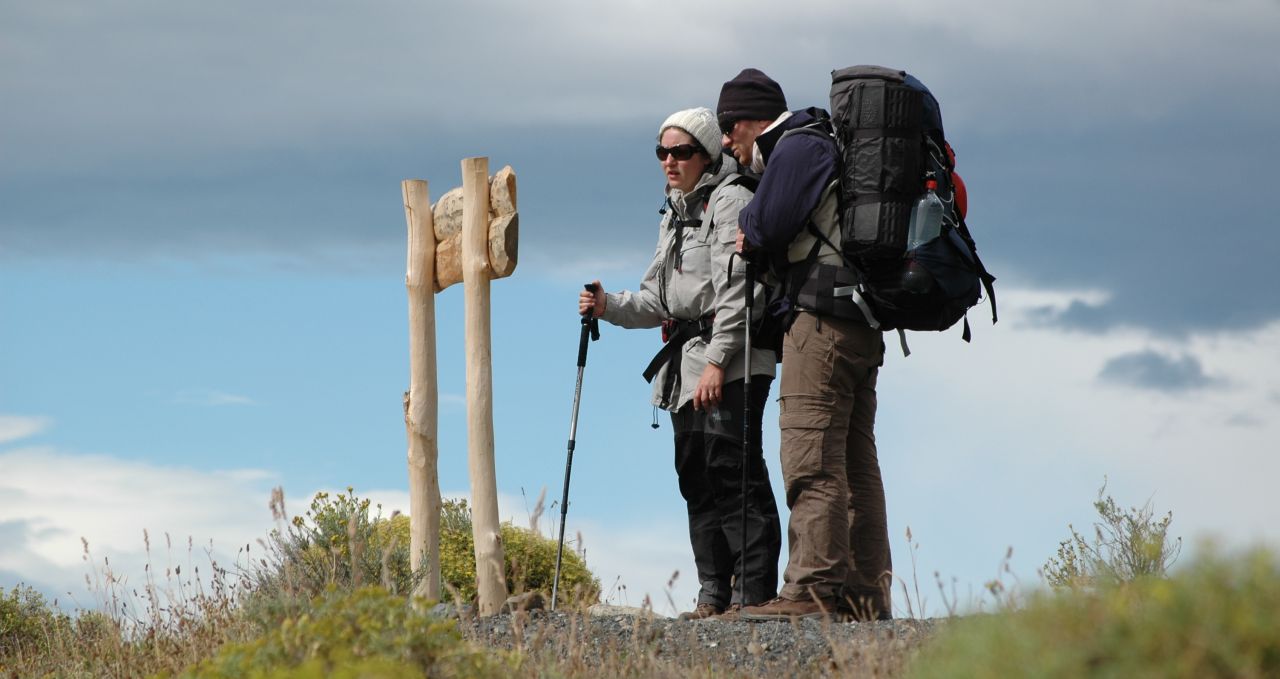
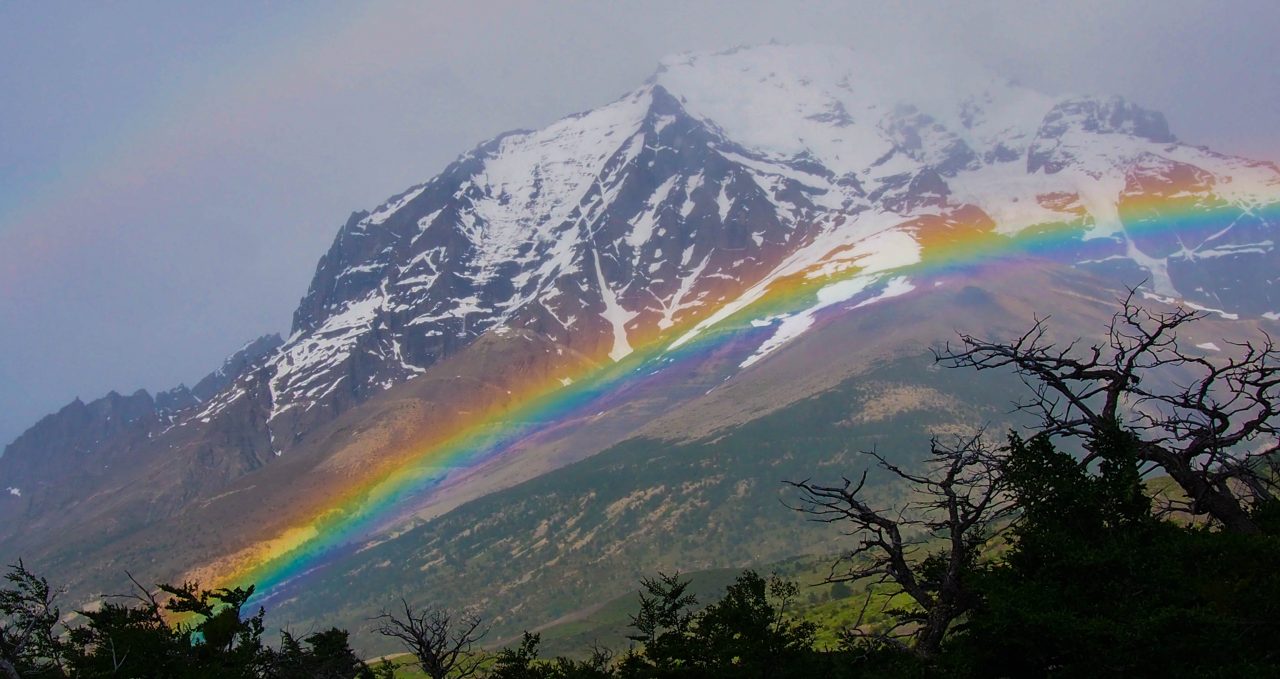
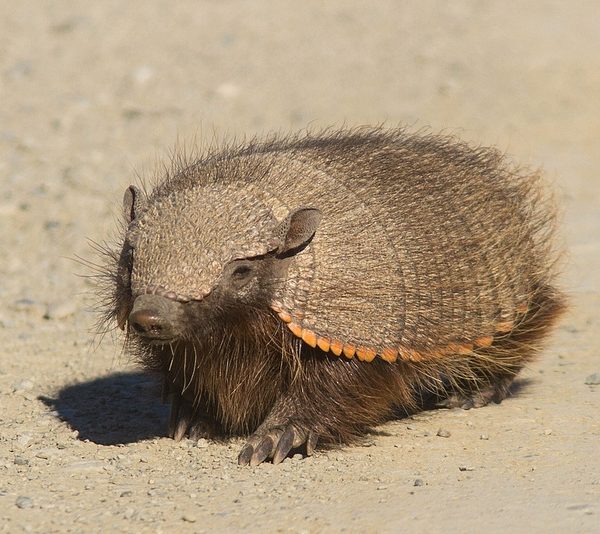
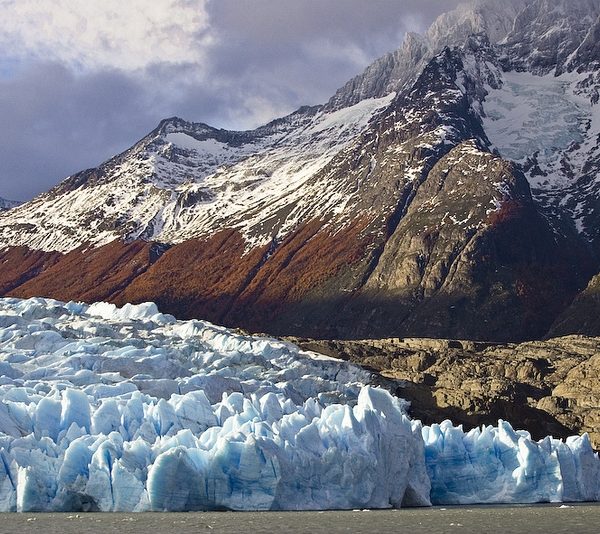
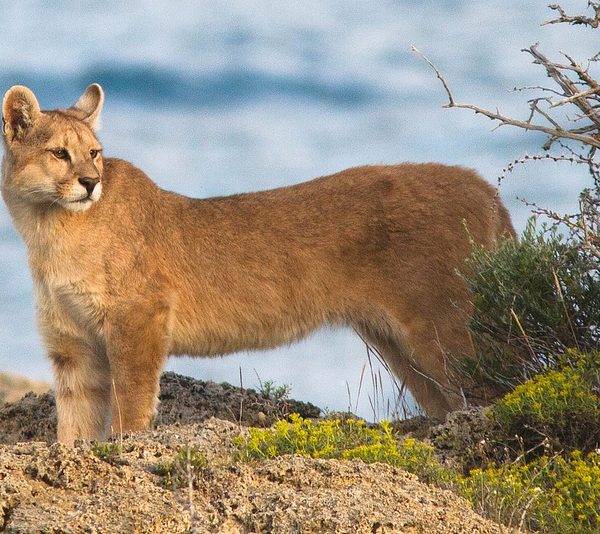
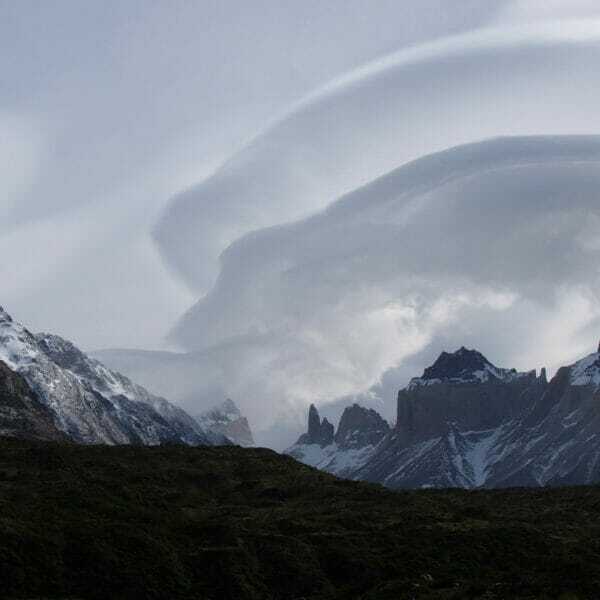
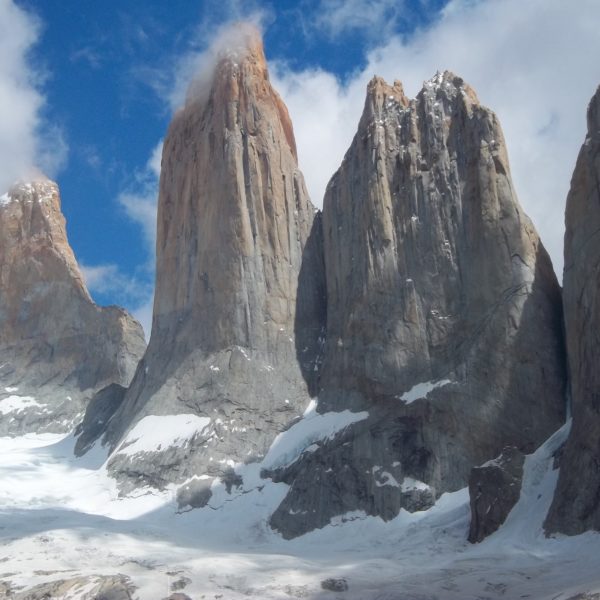
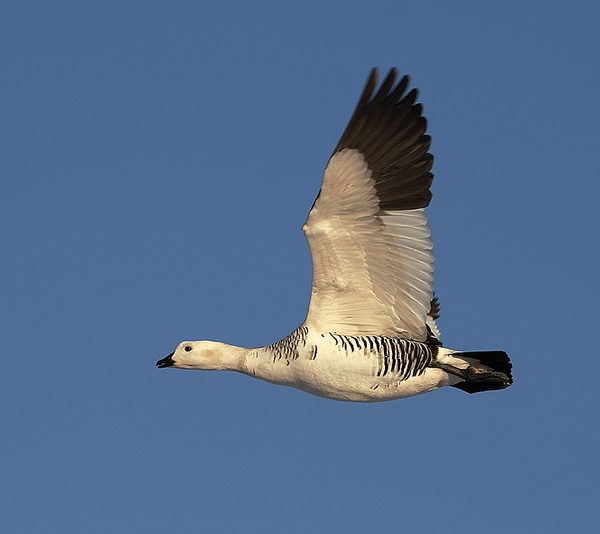
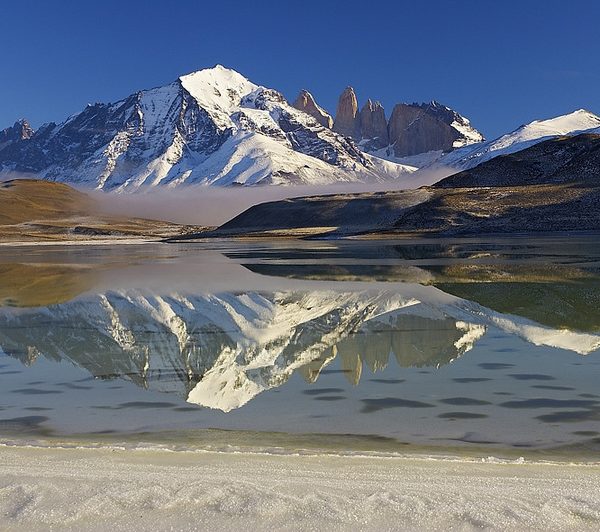
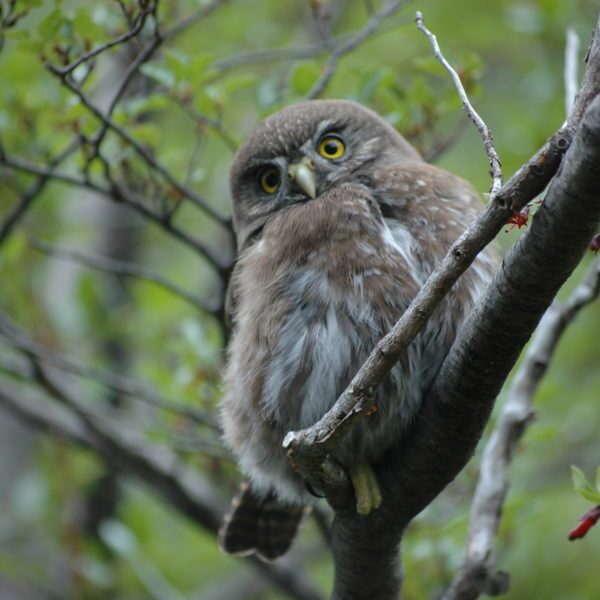
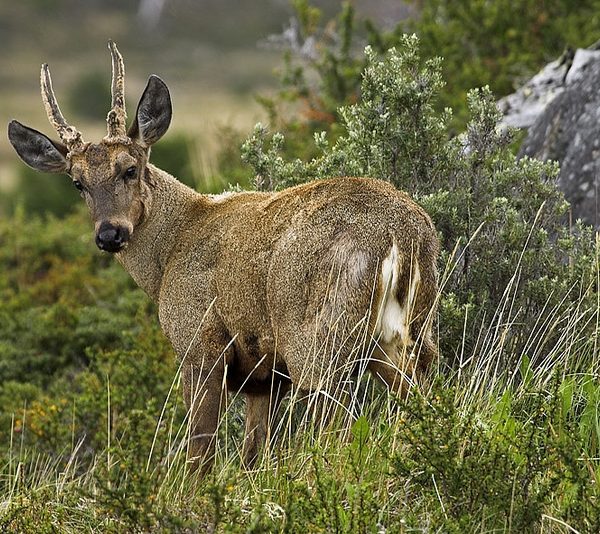
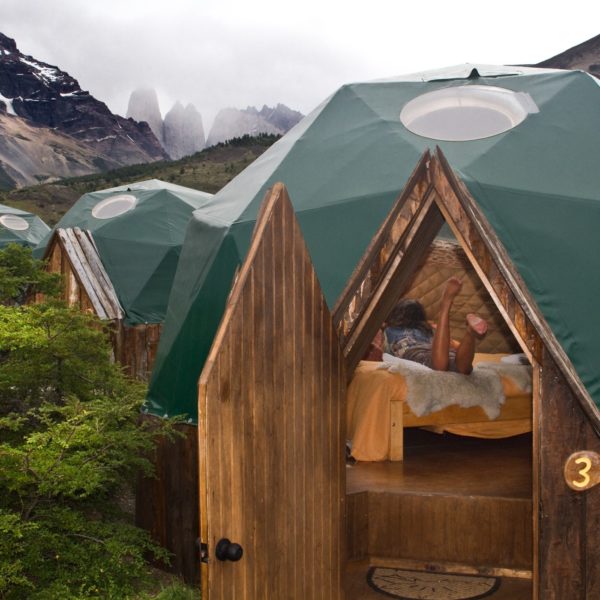
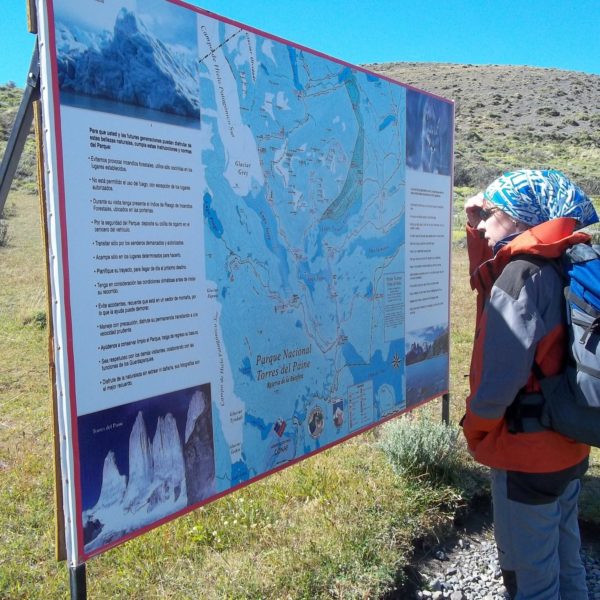
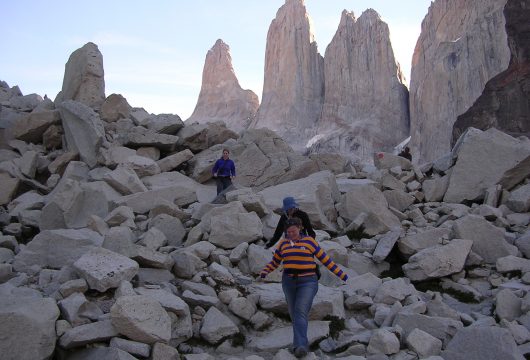
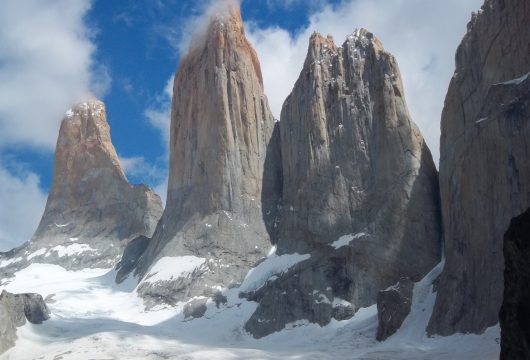
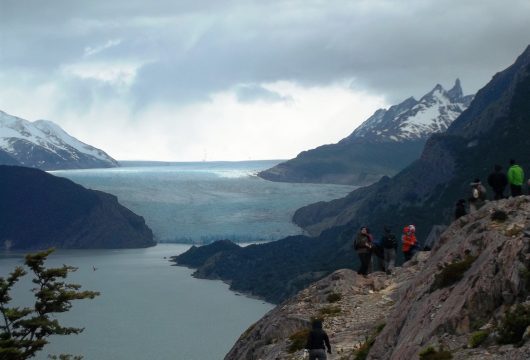
 a Group Tour
a Group Tour  a Tailor Made Tour
a Tailor Made Tour 